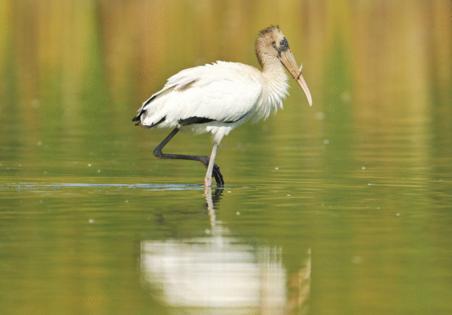Rare tropical bird, last seen in Colorado 91 years ago, is hanging out in metro Denver
Published in Science & Technology News
DENVER — When longtime birder Patrick O’Driscoll saw a massive tropical bird slowly flying over Denver’s City Park last weekend, he almost couldn’t believe his eyes.
Could it be a sandhill crane? No, that didn’t fit. It wasn’t a great blue heron, either.
“I was dumbfounded that it was a wood stork, which is not supposed to be around here,” O’Driscoll said.
Most often found in Florida and Mexico, a wood stork was last recorded in Colorado 91 years ago, according to records from Colorado Field Ornithologists.
Wood storks are North America’s only native stork and usually like living in southern swamps, according to the National Audubon Society. They’re mostly white with a naked, gray head and heavy bill, and typically grow to a little over 3 feet with a wing span of 5 feet or more.
O’Driscoll quickly took some photos as the stork circled Ferril Lake and headed west, and he shared them with the group’s mailing list while feeling a little guilty he was the only person to see the rare bird.
Until this week, when the wood stork was spotted hanging out in a pond in Broomfield, quickly drawing hundreds of birders from across the metro.
The August sightings are only the third time a wood stork has been recorded in Colorado, Peter Gent of Colorado Field Ornithologists said this week. The 1934 sighting was near the former Stapleton Airport. Before that, two wood storks were spotted at Fort Logan in 1902.
It’s not clear why this juvenile made the trek so far north, Gent said. A wood stork was also seen in Wisconsin earlier this month, another rare sighting.
“When birds get into odd places, it’s very frequently the juveniles that makes mistakes and get lost, so that’s consistent with it wandering some, but why the heck it’s here instead of Florida? Who knows,” he said.
There’s no telling how long the wood stork will hang around Alexx and Michael’s Pond near Zuni Street and West 132nd Avenue in Broomfield, Gent said.
An anhinga, which is also rarely seen in Colorado, camped out at a Boulder County pond for nearly 10 weeks before flying elsewhere earlier this summer.
“It’s absolutely not clear to me, but it seemed fairly content,” Gent said
-------
©2025 MediaNews Group, Inc. Visit at denverpost.com. Distributed by Tribune Content Agency, LLC.







Comments